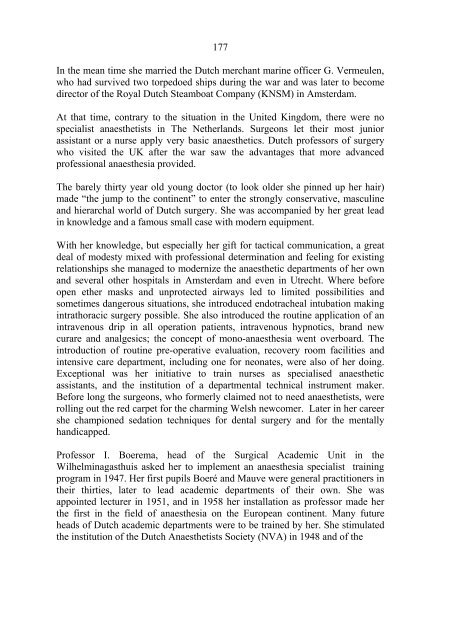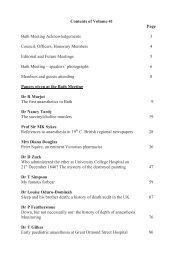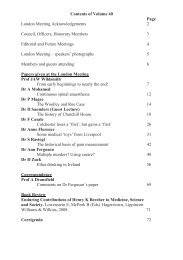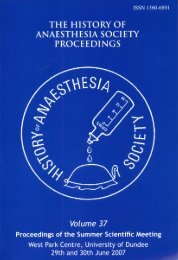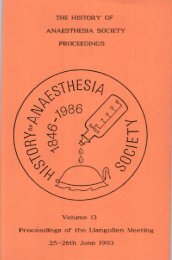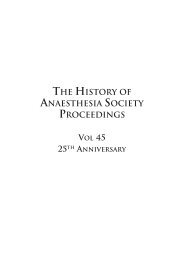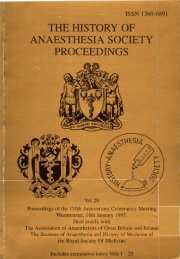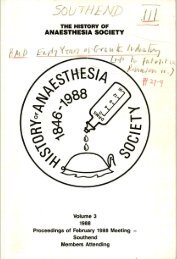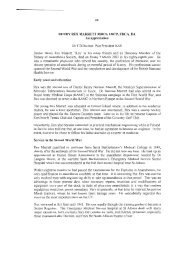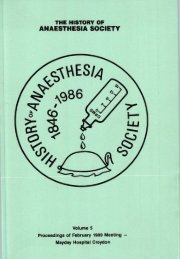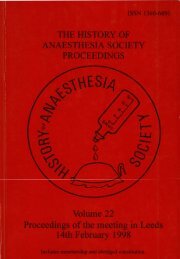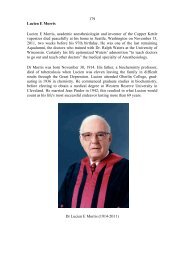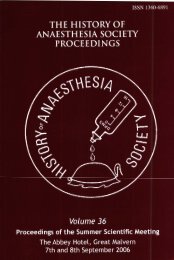Professor DME Vermeulen-Cranch - History of Anaesthesia Society
Professor DME Vermeulen-Cranch - History of Anaesthesia Society
Professor DME Vermeulen-Cranch - History of Anaesthesia Society
You also want an ePaper? Increase the reach of your titles
YUMPU automatically turns print PDFs into web optimized ePapers that Google loves.
177<br />
In the mean time she married the Dutch merchant marine <strong>of</strong>ficer G. <strong>Vermeulen</strong>,<br />
who had survived two torpedoed ships during the war and was later to become<br />
director <strong>of</strong> the Royal Dutch Steamboat Company (KNSM) in Amsterdam.<br />
At that time, contrary to the situation in the United Kingdom, there were no<br />
specialist anaesthetists in The Netherlands. Surgeons let their most junior<br />
assistant or a nurse apply very basic anaesthetics. Dutch pr<strong>of</strong>essors <strong>of</strong> surgery<br />
who visited the UK after the war saw the advantages that more advanced<br />
pr<strong>of</strong>essional anaesthesia provided.<br />
The barely thirty year old young doctor (to look older she pinned up her hair)<br />
made “the jump to the continent” to enter the strongly conservative, masculine<br />
and hierarchal world <strong>of</strong> Dutch surgery. She was accompanied by her great lead<br />
in knowledge and a famous small case with modern equipment.<br />
With her knowledge, but especially her gift for tactical communication, a great<br />
deal <strong>of</strong> modesty mixed with pr<strong>of</strong>essional determination and feeling for existing<br />
relationships she managed to modernize the anaesthetic departments <strong>of</strong> her own<br />
and several other hospitals in Amsterdam and even in Utrecht. Where before<br />
open ether masks and unprotected airways led to limited possibilities and<br />
sometimes dangerous situations, she introduced endotracheal intubation making<br />
intrathoracic surgery possible. She also introduced the routine application <strong>of</strong> an<br />
intravenous drip in all operation patients, intravenous hypnotics, brand new<br />
curare and analgesics; the concept <strong>of</strong> mono-anaesthesia went overboard. The<br />
introduction <strong>of</strong> routine pre-operative evaluation, recovery room facilities and<br />
intensive care department, including one for neonates, were also <strong>of</strong> her doing.<br />
Exceptional was her initiative to train nurses as specialised anaesthetic<br />
assistants, and the institution <strong>of</strong> a departmental technical instrument maker.<br />
Before long the surgeons, who formerly claimed not to need anaesthetists, were<br />
rolling out the red carpet for the charming Welsh newcomer. Later in her career<br />
she championed sedation techniques for dental surgery and for the mentally<br />
handicapped.<br />
<strong>Pr<strong>of</strong>essor</strong> I. Boerema, head <strong>of</strong> the Surgical Academic Unit in the<br />
Wilhelminagasthuis asked her to implement an anaesthesia specialist training<br />
program in 1947. Her first pupils Boeré and Mauve were general practitioners in<br />
their thirties, later to lead academic departments <strong>of</strong> their own. She was<br />
appointed lecturer in 1951, and in 1958 her installation as pr<strong>of</strong>essor made her<br />
the first in the field <strong>of</strong> anaesthesia on the European continent. Many future<br />
heads <strong>of</strong> Dutch academic departments were to be trained by her. She stimulated<br />
the institution <strong>of</strong> the Dutch Anaesthetists <strong>Society</strong> (NVA) in 1948 and <strong>of</strong> the


